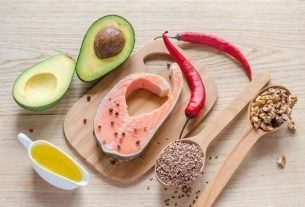Some foods, such as cocoa, oats, cashew nuts, green beans, guava, turmeric and apple, may be recommended to help lower blood cholesterol.
This is because these foods are rich in fiber and bioactive compounds with antioxidant and lipid-lowering properties, which prevent the oxidation of fat cells by free radicals and reduce fat absorption at the intestinal level.
However, to lower cholesterol, it is also essential to practice physical activity regularly and maintain a healthy diet, avoiding the consumption of foods rich in saturated fat and sugar, such as pizza, ice cream, mayonnaise, sausage and nuggets, for example.
Read too: Diet for high cholesterol: foods allowed and to avoid

Main foods
The main foods that help lower bad cholesterol are:
1. Cocoa
Cocoa helps lower cholesterol by containing flavonoids with antioxidant action, which reduce the oxidation of fat cells and improve blood flow, preventing the formation of atheroma plaques and the development of diseases such as atherosclerosis, heart attack and high blood pressure.
How to consume: You can consume cocoa fruit fresh or use cocoa powder, consuming around 2 teaspoons per day in fruit, porridge or in recipes such as hot chocolate, mousse and pudding. Cocoa can also be consumed by eating 40 grams of dark chocolate per day, which must contain at least 70% cocoa.
If you want to know how to follow a diet to lower cholesterol, make an appointment with the nutritionist closest to you:
Taking care of your health has never been easier!
2. Oats
Because it is rich in beta-glucan, a type of soluble fiber that reduces the absorption of fat in the intestine, oats are a good food for lowering “bad” cholesterol, LDL, in the blood, preventing the emergence of cardiovascular diseases, such as heart attack, atherosclerosis and stroke. Discover all the health benefits of oats.
How to consume: The recommended amount of oats is 2 tablespoons per day, which can be added to fruits, juices and yogurts or used to prepare porridge, soups, pies, cakes, breads and pastas.
3. Tomato
Tomato is a vegetable that helps lower cholesterol as it is rich in vitamin C and lycopene, a nutrient and a carotenoid that has antioxidant action, preventing the oxidation of fat cells and reducing the formation of blood cholesterol.
How to consume: Tomatoes can be consumed raw, cooked, dehydrated, in juices, sauces, soups or jellies, with seeds or skin so that all their properties can be used.
Read too: 12 benefits of tomatoes and how to consume them
4. Black beans
Black beans help lower cholesterol because they are rich in soluble fiber, a type of fiber that binds to cholesterol in the digestive system and sweeps it out of the body before it enters the bloodstream.
How to consume: The daily recommendation for legumes, including black beans, is 3 tablespoons, which can be used cooked and in recipes such as salads, soups, sweets or burgers.
5. Olive oil
Because it is rich in polyphenols, monounsaturated and polyunsaturated fatty acids with antioxidant action, olive oil helps lower “bad” cholesterol, LDL, in the blood, in addition to increasing levels of “good” cholesterol, HDL. See other health benefits of olive oil.
How to consume: Olive oil can be used cold, to season salads and vegetables, make sauces and prepare stews, for example. The recommended amount to obtain all the benefits of olive oil is 1 to 4 tablespoons per day.
6. Kale
Kale helps lower cholesterol as it is a vegetable rich in fiber that binds to cholesterol in the intestine, stimulating its elimination through feces and reducing its concentration in the body.
How to consume: Kale can be consumed raw or cooked, in juices, soups, stews, pies or sautéed in olive oil, for example.
7. Cashew Nuts
With good amounts of polyunsaturated fats and antioxidants, cashew nuts help lower “bad” cholesterol, LDL, in the blood, in addition to promoting increased levels of “good” cholesterol, HDL.
Furthermore, cashew nuts are also rich in fibers that reduce the absorption of cholesterol and triglycerides in the intestine, reducing their concentration in the body and preventing diseases such as heart attack and atherosclerosis.
How to consume: To obtain the benefits of cashew nuts, it is recommended to consume 30 to 40 g of this fruit per day, and preferably without additives such as sugar, fat and salt. Cashew nuts can be consumed along with fruit or yogurt, or added to recipes such as salads, pastas, vegetable milks, cookies and breads.
8. Apple
Apples are a good food for lowering cholesterol, because they are rich in pectin, a type of fiber that reduces the absorption of fats, preventing cardiovascular diseases, such as heart attack, atherosclerosis or stroke.
Furthermore, apples also contain flavonoids and carotenoids, bioactive compounds with antioxidant action that prevent the oxidation of fat cells, helping to balance “bad” cholesterol levels in the blood.
How to consume: Apples can be consumed raw, preferably with the peel, or can be used to prepare salads, juices, cakes, purees and smoothies.
Read too: 13 health benefits of apples and how to consume them
9. Turmeric
Because it contains curcumin, demethoxycurcumin and bisdemethoxycurcumin, bioactive compounds with antioxidant action, turmeric helps lower cholesterol and triglycerides in the blood, preventing the emergence of diseases such as heart attack, heart failure and atherosclerosis.
How to consume: To obtain its benefits, you can use turmeric to season preparations such as soups, meats and vegetables. Furthermore, turmeric can also be used to prepare teas. See other ways to use turmeric.
10. Green beans
Green beans are a food that helps lower cholesterol, as they contain fibers that reduce the absorption of this type of fat in the intestine, causing them to reduce their concentration in the body in the long term.
How to consume: The pod can be consumed cooked, steamed or grilled, in preparations such as salads, stews, pies, soups and farofas.
11. Guava
Because it has good amounts of antioxidant nutrients, such as vitamin C and vitamin A, guava is a good food for lowering cholesterol as it helps prevent the oxidation of fat cells.
Furthermore, guava is also rich in fiber that facilitates the elimination of cholesterol through feces, reducing its concentration in the blood.
How to consume: Guava can be consumed raw, or in preparations such as juices, smoothies, fruit salads and popsicles, for example.
12. Salmon
Salmon is a good food for reducing “bad” cholesterol as it is rich in omega 3, omega 6 and omega 9 fatty acids, which are healthy fats with anti-inflammatory action that help regulate cholesterol and triglyceride levels. Check out all the benefits of salmon.
Furthermore, the omega 3 present in salmon also promotes increased levels of “good” cholesterol, HDL, in the blood.
How to consume: Salmon can be made raw, in preparations such as ceviche, sashimi, tartar and salmon carpaccio. This fish can also be baked or grilled. To obtain the benefits of this fish, it is recommended to eat a portion of 85 g of salmon, 2 to 3 times a week.
13. Persimmon
As a fruit with a high fiber content, persimmon reduces the absorption of fats at the intestinal level, helping to lower cholesterol and triglycerides in the blood.
How to consume: Persimmon can be consumed raw or used in recipes, such as salads, juices, sorbet, cakes and sauces.
Read too: Persimmon: 10 benefits and how to eat it (with recipes)
14. Matter
Jambo contains anthocyanins and flavonoids, which are bioactive antioxidant compounds that prevent the oxidation of fat cells, helping to lower blood cholesterol.
Furthermore, jambo is also rich in fiber that reduces the absorption of fat from food at the intestinal level, balancing cholesterol and triglyceride levels.
How to consume: You can consume jambo naturally or in preparations such as juices, salads, jellies and mousses.
Other tips for lowering cholesterol
Some tips that help lower “bad” cholesterol are:
- Practice moderate to high intensity physical activity, 3 to 4 times a week, lasting at least 40 minutes, such as dancing, swimming, weight training or running, for example, as they help the body transport “bad” cholesterol to the liver, where it can be removed from the blood;
- Avoid or stop smoking and/or avoid exposure to cigarette smoke, as tobacco increases the risk of heart diseases, such as hypertension and diabetes;
- Maintain adequate weight, because being overweight can cause an increase in “bad” cholesterol and a decrease in “good” cholesterol levels in the blood;
- Avoid alcoholic drinks, as avoiding alcohol helps the liver work better to remove bad cholesterol from circulation.
Furthermore, it is also important to avoid foods that can increase blood cholesterol levels, such as those rich in saturated and trans fat, including butter, lard, bacon, crackers, ready-made sauces and pizza.

Sign up for our newsletter and stay up to date with exclusive news
that can transform your routine!
Warning: Undefined array key "title" in /home/storelat/public_html/wp-content/plugins/link-whisper-premium/templates/frontend/related-posts.php on line 12
Warning: Undefined array key "title_tag" in /home/storelat/public_html/wp-content/plugins/link-whisper-premium/templates/frontend/related-posts.php on line 13



